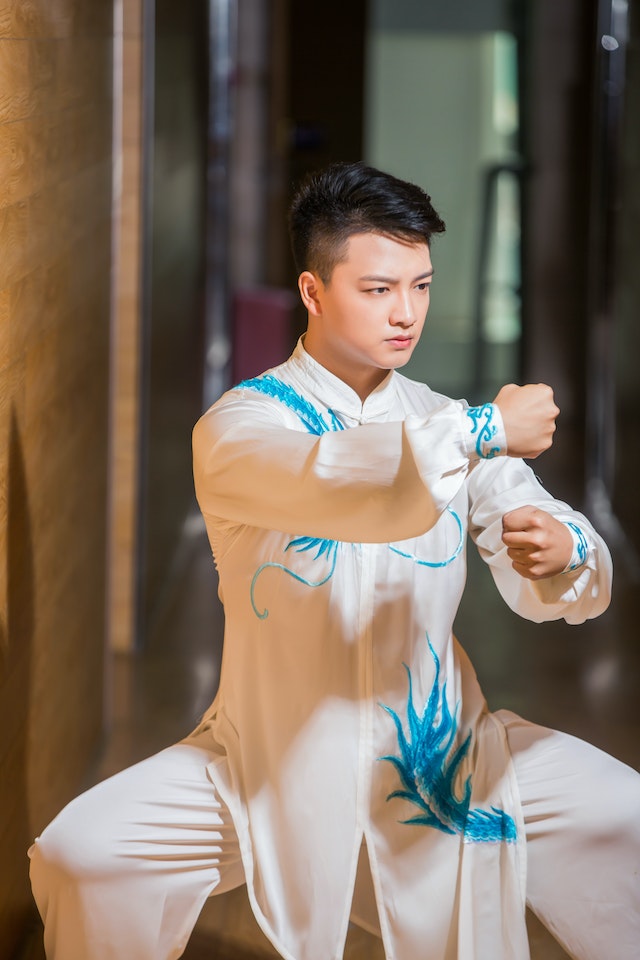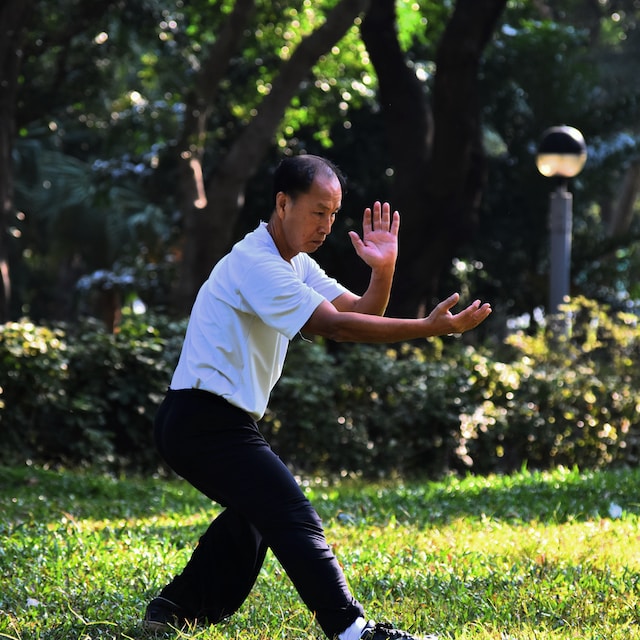
Framed within the tapestry of Chinese culture, Tai Chi is a spiritual embodiment of balance and harmony. Less of an alternative medicine but more of an art form, It originated centuries ago as a form of martial art and has since evolved into a graceful sequence of deliberate, flowing movements. Rooted in Taoist philosophy, Tai Chi embraces the concept of yin and yang, the eternal dance of opposing forces, seeking equilibrium in every aspect of our existence.
The Fluidity of Motion
At the heart of Tai Chi lies a seamless fusion of mind, body, and spirit. Its movements are akin to a slow, majestic symphony—an invitation to reclaim our inner rhythm and reconnect with the world around us. Every gesture, every shift in weight, is a deliberate step towards awakening our energy, known as chi, and guiding it through the meridians of our being.
The Benefits of Tai Chi
Beyond its captivating aesthetics, Tai Chi bestows a multitude of benefits upon its practitioners. Its gentle yet purposeful movements enhance strength, flexibility, and balance. Through a continuous flow of energy, this ancient art form reduces stress and cultivates a profound sense of inner peace. It is said that practicing Tai Chi can foster mental clarity, improve cardiovascular health, and enhance the immune system. Moreover, it instills discipline, patience, and resilience, qualities that permeate every facet of our lives.
The Philosophy and Principles of Tai Chi
Tai Chi, regarded as a moving meditation, encompasses a rich philosophy and set of principles that guide its practice. Dive deeper into the profound wisdom that underlies this ancient art form and discover how its philosophy can transform our lives.
Yin and Yang: The Dance of Opposites
In Tai Chi, the concept of yin and yang takes center stage. Yin represents stillness, darkness, and the feminine aspects of existence, while yang symbolizes movement, light, and the masculine qualities. Tai Chi seeks to harmonize these opposing forces, recognizing that balance and harmony can only be achieved when both aspects are in equilibrium.

Wu Wei: The Art of Non-Doing
Wu Wei, meaning “effortless action,” is a central principle in Tai Chi philosophy. It advocates for a state of flow where we act without force or resistance, allowing events to unfold naturally. By embracing the art of non-doing, it teaches the value of surrendering control and trusting in the inherent wisdom of the universe.
Softness and Yielding: The Power of Flexibility
Tai Chi emphasizes softness and yielding as sources of power. Rather than relying on brute force, practitioners learn to be supple, flexible, and responsive. By yielding to the opposing forces encountered in life, we can redirect their energy and maintain our own stability.
Mindfulness and Inner Awareness
Mindfulness plays a vital role in Tai Chi practice. As we flow through the graceful movements, we are encouraged to be fully present in the moment, observing the sensations, thoughts, and emotions that arise. Cultivating inner awareness allows us to deepen our connection with ourselves and gain insight into our inner landscape.
The Three External Harmonies
Tai Chi emphasizes the alignment of the body, breath, and mind, known as the three external harmonies. By synchronizing these elements, we create a state of coherence, where our physical, mental, and energetic aspects are in harmonious unity. This alignment not only enhances the effectiveness of our practice but also extends to our daily lives, fostering a state of overall well-being.
Tai Chi Forms and Styles
Within the realm of Tai Chi, a myriad of forms and styles are cultivated, each with its distinct characteristics and nuances. These forms, akin to choreographed dances, are a pathway to deepening our connection with the art and unlocking its transformative power.
Yang Style
The Yang style, with its flowing, expansive movements, is the most widely practiced form around the world. Named after its founder, Yang Luchan, this style embodies grace and power in equal measure. Its slow, smooth motions emphasize relaxation and gentle transitions, allowing practitioners to cultivate physical and mental balance. The Yang style is characterized by its large, circular movements and balanced stances, providing a firm foundation for the cultivation of chi.
Chen Style
With its deep-rooted history, the Chen style is the oldest known form, tracing its origins back to the 17th century. Named after the Chen family from Chenjiagou village in China, this style encompasses both explosive movements and slow, graceful transitions. It seamlessly interweaves fast-paced bursts of power with gentle, flowing motions, often incorporating intricate spiraling and silk-reeling techniques. Practicing the Chen style builds strength, agility, and internal power.
Wu StylE
The Wu style, founded by Wu Quanyou, is characterized by its compact movements and small, circular footwork. It is known for its emphasis on relaxation and subtlety, as practitioners cultivate internal energy through focused concentration. The Wu style places an emphasis on precision and precision, requiring strict attention to detail in every posture and transition. This style is particularly favored by those seeking a harmonious blend of power and grace.
Sun Style
The Sun style, developed by Sun Lutang, combines elements of Tai Chi, Xingyi, and Bagua, resulting in a unique and versatile form. It incorporates gentle flowing movements with sudden bursts of energy, exemplifying the principle of softness overcoming hardness. The Sun style places a strong emphasis on agility, flexibility, and footwork, making it a popular choice for those seeking a dynamic and lively practice.
Other Styles
In addition to the widely known Yang, Chen, Wu, and Sun styles, there are various other styles practiced worldwide. These include the Hao style, Li style, and a multitude of derivative forms that have evolved over time. Each style carries its own distinct flavor and methodology, offering practitioners a diverse range of approaches to explore the profound depths of Tai Chi.
The Physical and Mental Benefits of Tai Chi
Tai Chi is much more than an elegant dance; it is a holistic practice that transcends physical exercise. Its slow, deliberate movements, combined with focused breathing and mindfulness, offer a myriad of benefits for both the body and mind. In this section, we will explore the physical and mental rewards that Tai Chi bestows upon its practitioners.
- Enhanced Physical Strength and Flexibility
Tai Chi’s gentle, flowing movements may appear effortless, but they engage the entire body, toning muscles and improving strength. Regular practice improves flexibility, as it emphasizes fluidity of motion, promoting joint mobility and reducing stiffness. The controlled shifting of weight and coordination of limbs challenges and improves balance, reducing the risk of falls, especially in older adults.

- Reduced Stress and Increased Relaxation
Tai Chi’s meditative nature fosters relaxation and aids in stress reduction. Its slow, rhythmic movements synchronize with deep breathing, activating the body’s relaxation response and calming the nervous system. Engaging in Tai Chi regularly helps lower cortisol levels, the hormone responsible for stress, promoting a sense of calm and tranquility.
- Mental Clarity and Cognitive Benefits
Tai Chi requires focus, attention, and mindfulness, enhancing cognitive function and sharpening mental acuity. Through the integration of mind and body, Tai Chi facilitates a state of flow, where thoughts and distractions diminish, allowing for mental clarity and present-moment awareness. Research suggests that regular Tai Chi practice may improve cognitive performance, memory, and attention span, contributing to overall brain health.
- Cardiovascular Health:
Despite its slow tempo, Tai Chi is a gentle aerobic exercise that benefits cardiovascular health. The rhythmic movements help regulate blood pressure and improve circulation, reducing the risk of heart disease and stroke. Engaging in Tai Chi regularly can lower LDL cholesterol levels and increase HDL cholesterol levels, promoting a healthier cardiovascular system.
- Boosted Immune System
Tai Chi’s focus on breath control and relaxation supports the immune system by reducing inflammation and enhancing immune function. Its gentle movements stimulate the lymphatic system, promoting detoxification and improving the body’s ability to defend against infections and diseases. Regular practice has been linked to a more robust immune response and increased antibody production.
Tai Chi is a treasure trove of physical and mental benefits, offering a comprehensive approach to well-being. By harmonizing body, mind, and spirit, this ancient practice enriches our lives in countless ways. Its graceful movements, combined with breath awareness, cultivate strength, flexibility, and balance, while reducing stress and promoting relaxation. Engaging in regular Tai Chi practice may not only improve physical health but also enhance mental clarity, cognitive function, and immune system function. Embark on the journey of Tai Chi and unlock the full potential of your well-being.
